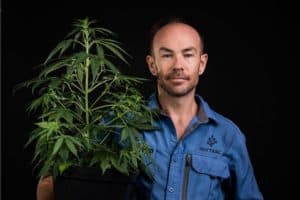 Founder and CEO Owen Darby is a solutions enthusiast. Originally from Australia, he’s had a fascinating career. Working in the oil and energy sector, Owen specialised in finding solutions. He was in charge of managing highly controlled explosions and in researching cutting-edge prototype technology that could provide very specific solutions to very specific problems. “As an entrepreneur, all you’re looking for is problems and solutions,” explains Owen. “ That was my day job. Adapting and modifying to get to the end goal.
Founder and CEO Owen Darby is a solutions enthusiast. Originally from Australia, he’s had a fascinating career. Working in the oil and energy sector, Owen specialised in finding solutions. He was in charge of managing highly controlled explosions and in researching cutting-edge prototype technology that could provide very specific solutions to very specific problems. “As an entrepreneur, all you’re looking for is problems and solutions,” explains Owen. “ That was my day job. Adapting and modifying to get to the end goal.
Throughout my career, I was given the opportunity to do research and development with lots of technologies and roll them out in Australia, New Zealand, Kazakhstan and the Middle East. “Once I completed one job, they started throwing more at me. Thee sector has all sorts of curly problems.”
Owen moved to Otago in 2010 and developed an interest in medicinal cannabis. In 2018, he started Meraki Natural, a medicinal cannabis company that took a sustainable, circular approach to business. He spent years researching the science and opportunities, designing technology that worked in sync with the Otago environment.
High competition and restrictive medicinal cannabis laws made the project difficult, but Owen’s research helped him discover another use for cannabis: phytoremediation. “Hemp lead us to Phytrac because it’s really good at cleaning the soil. It’s hungry for metal, phosphorus and nitrates. […] is is a natural process of the plant. It’s looking for some food. It’s like a pumping system. The plant’s roots will reach out to whatever it can find and some plants, like hemp, are hyper-accumulators.
“It’s an alien sort of concept, but really, the plant is just looking for food.” Using some of the equipment he’d already developed – including commercial refrigerators up-cycled into growing cabinets – Owen began looking at plants like cannabis and sunflowers and how they could be used to clean contaminated sites. Phytrac is the result.
 Phytoremediation technologies use plants like cannabis and sunflowers to clean up soil, air, and water contaminated with hazardous contaminants.
Phytoremediation technologies use plants like cannabis and sunflowers to clean up soil, air, and water contaminated with hazardous contaminants.
As we expand our cities and new industries are created, we degrade land and create contaminated soil and wastewater sludge. In New Zealand, we produce more than 300,000 tonnes of wastewater sludge each year. Contaminated land is “cleaned up” by digging out the offending soil and dumping it in a landfill. This is expensive (costing around $40 million per year), leaves an inconvenient hole to be filled and moves the problem to our ever-growing landfills.
Phytoremediation, using plants to absorb these contaminants, is a more sustainable solution. The concept isn’t new, but its uptake has been hindered by a lack of accurate data and a “plant and pray” approach. “It is low technology. Plants have always been really good at fixing things if you give them enough time. But we can’t utilise that effectively without a full understanding of that process, monitoring it and understanding how we can optimise it
“[…] we’re bringing consistency by dragging all of this information, all of the research over the past 30 years and science that’s proven, and we’re making algorithms.” Owen says it’s like baking a cake; you need the right ingredients, in the right proportions, for successful (and swift) phytoremediation. Phytrac is a technology platform that provides this strategic guidance – the ingredients list and the method. The Frankton-based lab studies plants and soils to refine data and algorithms to determine that perfect cake mix. “We know that this soil type with this contaminant will equal this equation, so you need to meet these conditions (whether that’s PH or the organics present). It’s like baking a cake. You need these ingredients so you can utilise the plant correctly.
“It’s a complicated equation and there are many variables, so there is a lot of inconsistency in the way that the solutions are rolled out. “That’s why we need to get a robot involved and that is what we’re doing. We plug in all of the information about your contaminated earth and we are going to produce an action plan to say: you need to do this, with this plant, in this space, with these things presents to achieve the result you want.”
 Owen’s proud to be developing a deep tech venture right here in Queenstown. He recognises the opportunity to export his technology and has a partnership with Bridgewest Ventures and support from Callahan’s CleanTech project.
Owen’s proud to be developing a deep tech venture right here in Queenstown. He recognises the opportunity to export his technology and has a partnership with Bridgewest Ventures and support from Callahan’s CleanTech project.
Owen’s proud to be developing a deep tech venture right here in Queenstown. He recognises the opportunity to export his technology and has a partnership with Bridgewest Ventures and support from Callahan’s CleanTech project.
What’s being developed in a garage/lab in Frankton could one day be assisting industries around the world to clean up land and waterways in a more efficient, sustainable and affordable way.
“We want to provide a dynamic, data-driven platform to revolutionise the global implementation and monitoring of Phytosystems that restore, regenerate and reclaim contaminated earth. “[…] We have something that’s very unique. We’re the intersection of science, technology and nature. You won’t find a lab that has a capacity like we do in all of New Zealand. And we do it all from Queenstown.”